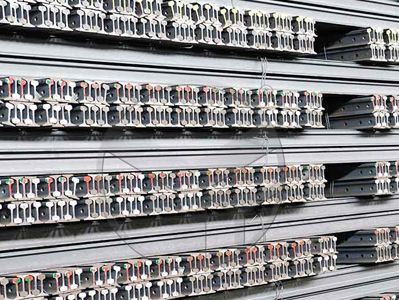What Are the Three Types of Rail?
There are three main types of rails. Double headed rails, bull headed rails and flat footed rails. You will come to know all the important details of each of them with figures in the blog.
Let's start at the beginning. What are rails?
What are Rails?
Rails are an important part of railroad tracks. They are rolled sections of high carbon steel, laid in two parallel lines end to end above sleepers, providing a continuous and horizontal surface for trains to move and carry the axle loads of rolling stock.
Let's take a closer look at the types of rails.
The main types of rails
There are mainly 3 types of rails.
1. Double headed rails
Double-headed rails indicate the early stage of development. It basically consists of three parts, such as the upper table, Web and the following table. The upper and lower tables are the same, and they are introduced in the hope of doubling the life of the guide.
When the upper table was used up, the armrests could be turned upside down on the chair so that the lower table could be used.
But this idea soon proved to be wrong, because the constant contact between the lower table and the chair made the surface of the lower table rough, so it was impossible for the train to run smoothly.
As a result, this type of rail is practically no longer in use. Today, these rails are available in lengths ranging from 20 to 24.
Rails with the same foot and head dimensions are called double-ended rails. Initially, these rails were widely used for railroad tracks.
The idea behind using these rails was that the rails could be inverted and reused when the head was worn out due to the frictional action of the wheels. However, from experience, it was found that their feet could not be used as a running surface because it would also wrinkle under the impact of wheel loads.
It's time to get to know the second type of rails, and they are bullhead rails.
2. Bull headed rails
A rail with a head size larger than the foot size is called a bullhead rail. In this type of rail, the head is slightly thicker and stronger than the lower part by adding more metal to it. These rails also require chairs to hold them in place.
Bull headed rails are especially used for making points and crossovers. These rails also consist of three parts: head, belly and foot. These rails are made of steel.
The head is larger than the feet, and the feet are designed only to properly support the wooden keys that hold the rails in place. Therefore, the feet are designed only to provide the necessary strength and stiffness to the rails.
With these handrails, two cast iron chairs were required for each sleeper. They ranged in weight from 85 to 95 pounds and could be up to 60 feet long.
That's about the Bull headed rail. Let's move on to the third member of the list of rail types, the flat-footed rail.
3. Flat-footed rails
These rails were first invented in 1836 by Charles Vignoles, and so are also known as Vignols rails. They are divided into three sections:
The head
The web
The foot
This type of rail has grown in popularity to the point where it now makes up over 90% of all railway lines in the world.
The benefits of flat-footed rails are as follows:
They don't require a chair and can be spiked or keyed to the sleepers directly.
They are thus cost-effective. They're less expensive than bull-headed rails.
Both vertically and laterally, they are substantially stiffer; for curves, lateral rigidity is crucial.
They are less prone to kinking and have a more consistent top surface than bull-headed rails.
The weights from train wheels are distributed over a large number of sleepers and hence a broader area, resulting in increased track stability, longer rail and sleeper life, lower maintenance costs, less rail failure, and fewer traffic delays.

评论
发表评论